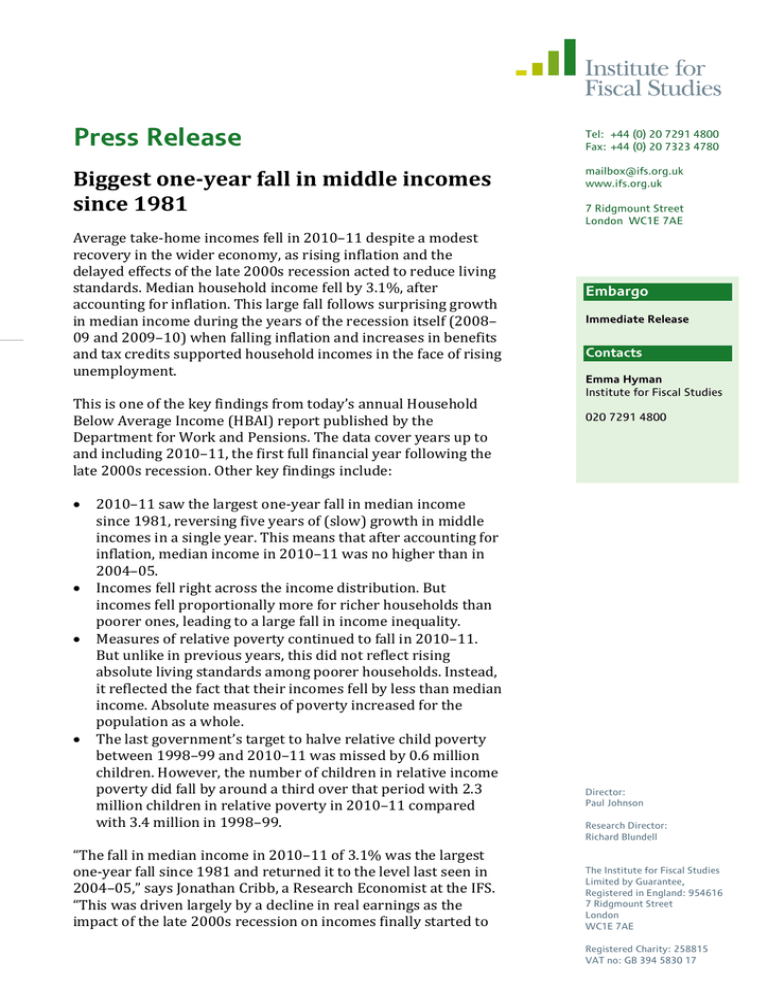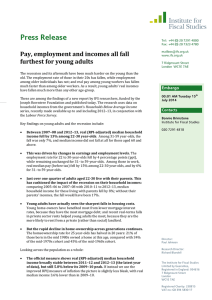Press Release Biggest one-year fall in middle incomes since 1981
advertisement

Press Release Tel: +44 (0) 20 7291 4800 Fax: +44 (0) 20 7323 4780 Biggest one-year fall in middle incomes since 1981 mailbox@ifs.org.uk www.ifs.org.uk Average take-home incomes fell in 2010–11 despite a modest recovery in the wider economy, as rising inflation and the delayed effects of the late 2000s recession acted to reduce living standards. Median household income fell by 3.1%, after accounting for inflation. This large fall follows surprising growth in median income during the years of the recession itself (2008– 09 and 2009–10) when falling inflation and increases in benefits and tax credits supported household incomes in the face of rising unemployment. This is one of the key findings from today’s annual Household Below Average Income (HBAI) report published by the Department for Work and Pensions. The data cover years up to and including 2010–11, the first full financial year following the late 2000s recession. Other key findings include: 2010–11 saw the largest one-year fall in median income since 1981, reversing five years of (slow) growth in middle incomes in a single year. This means that after accounting for inflation, median income in 2010–11 was no higher than in 2004–05. Incomes fell right across the income distribution. But incomes fell proportionally more for richer households than poorer ones, leading to a large fall in income inequality. Measures of relative poverty continued to fall in 2010–11. But unlike in previous years, this did not reflect rising absolute living standards among poorer households. Instead, it reflected the fact that their incomes fell by less than median income. Absolute measures of poverty increased for the population as a whole. The last government’s target to halve relative child poverty between 1998–99 and 2010–11 was missed by 0.6 million children. However, the number of children in relative income poverty did fall by around a third over that period with 2.3 million children in relative poverty in 2010–11 compared with 3.4 million in 1998–99. “The fall in median income in 2010–11 of 3.1% was the largest one-year fall since 1981 and returned it to the level last seen in 2004–05,” says Jonathan Cribb, a Research Economist at the IFS. “This was driven largely by a decline in real earnings as the impact of the late 2000s recession on incomes finally started to 7 Ridgmount Street London WC1E 7AE Embargo Immediate Release Contacts Emma Hyman Institute for Fiscal Studies 020 7291 4800 Director: Paul Johnson Research Director: Richard Blundell The Institute for Fiscal Studies Limited by Guarantee, Registered in England: 954616 7 Ridgmount Street London WC1E 7AE Registered Charity: 258815 VAT no: GB 394 5830 17 become clear. Inequality also fell as those on benefits had their incomes relatively better protected. Looking ahead, our forecasts suggest that median incomes will have fallen further in 2011–12 and median incomes will be no higher in 2015–16 than they were in 2002–03.” “Although the last government’s 2010–11 relative child poverty target was missed, large increases in benefits and tax credits for families with children mean child poverty has fallen substantially since 1998–99 and is at its lowest level since 1984.” says Robert Joyce, a Senior Research Economist at the IFS. “The Government has re-stated its commitment to the 2020–21 income-based child poverty targets that it inherited. But it is still in the position of having targets looming in just eight years without policies which give it a realistic chance of meeting them.” Looking at the figures in more detail shows us that: Falls in average income undo the last five years of growth... The 3.1% fall in median income was the largest one-year fall since 1981, undoing five years of slow growth. This means that after accounting for inflation, median income in 2010–11 was around the same level as in 2004–05. Mean income fell even more dramatically. But this was in part driven by one off behavioural effects surrounding the introduction of the 50p tax rate so it is hard to know the scale of the underlying fall. ... and largely driven by a falls in earnings The falls in average incomes were largely driven by falls in the real earnings of those employed. Rising inflation also led to realterms reductions in the value of state benefits and tax credits in 2010–11. This contrasts with the two years of the recession itself (2008– 09 and 2009–10) when falling inflation and increases in benefits and tax credits supported household incomes in the face of rising unemployment. The falls in income 2010–11 represent the delayed effect of the recession on living standards. Therefore while the effects of the recession on average income was not felt immediately, the pain was not avoided for long. Income inequality falls Incomes fell right across the income distribution in 2010–11, but the falls were proportionately larger among households with The Institute for Fiscal Studies Limited by Guarantee, Registered in England: 954616 7 Ridgmount Street London WC1E 7AE higher incomes than households with lower incomes. Income inequality therefore fell. Incomes at the 10th percentile of the income distribution fell by 1.1%, while incomes at the 90th percentile fell by a much larger 5.1%. Together, this meant that the 90/10 ratio, which measures how many times higher income at the 90th percentile is compared to income at the 10th percentile, fell from 4.1 to 3.9, its lowest level since 1987. The Gini coefficient, a commonly used measure of income inequality that summarises changes right across the income distribution, also fell substantially (2 percentage points from 0.36 to 0.34) undoing the increase in this measure of inequality that has occurred since 1997–98. Even so income inequality remains considerably higher than it was before the big rise in inequality that took place during the 1980s. This is illustrated in the table below. Inequality measures since 1961 Measure 1961 1970 1980 1990 2000– 01 2010–11 Gini 0.26 0.26 0.26 0.34 0.35 0.34 90/10 ratio 3.2 3.2 3.2 4.4 4.2 3.9 Relative child poverty falls but 2010 targets missed The official measure of relative child poverty is the number of children living in households with incomes below 60% of the median, measured before housing costs (BHC). On this basis, relative poverty fell by 0.3 million in 2010–11, driven by falls in median income. The incomes of low income households with children were themselves broadly unchanged in 2010–11. The fall in this measure of poverty therefore reflects a fall in the poverty line rather than an increase in the incomes of poor children. The last government set a target to halve the number of children in relative poverty between 1998–99 and 2010–11. The latest year of data confirms that this target was missed by 0.6 million: there were 2.3 million children in relative poverty on this basis in 2010–11 versus a target of 1.7 million (there were 3.4 million children in relative poverty in 1998–99). That said the fall in this measure of relative child poverty was substantial, and undid much (but not all) of the rise in child poverty that took place during the 1980s. Relative child poverty in 2010–11 was at its lowest level since 1984. The number of children in absolute low income poverty – using a poverty line The Institute for Fiscal Studies Limited by Guarantee, Registered in England: 954616 7 Ridgmount Street London WC1E 7AE fixed at 60% of the 1998–99 median – was more than halved from 3.4 million in 1998–99 to 1.4 million in 2010–11. Previous research suggests that a large part of the fall in child poverty since the late 1990s is due to increases in the generosity of benefits and tax credits for families with children. Spending on such benefits rose by £18 billion per year by 2010–11 as a result of policy decisions taken by the last government. In the current fiscal climate, further increases in generosity look unlikely and, as we have said before, this leaves almost no chance that targets to ‘eradicate’ child poverty by 2020 will be met. As we say in an accompanying observation, measuring the numbers of children with incomes less than 60% of median income may be valuable, but it cannot be the only way of assessing poverty. Over short periods, changes in such relative poverty measures may not be very informative. Over longer periods of time, though, we are likely to worry about the numbers of children whose living standards are falling a long way behind the rest of the population. Income poverty among adults Among the population as a whole a fall in the incomes of the poor meant that absolute poverty rose. But because the fall in incomes of the poor were less than the fall in median income relative poverty fell. Relative poverty among pensioners is at its lowest level since 1984. Although absolute poverty among pensioners increased by 0.1 million, it remains close to historic lows and significant growth in the real incomes of pensioners in recent decades mean it has declined dramatically since the 1980s. In contrast, relative poverty among working age adults without children remains close to its highest level since at least 1961 on both a BHC and AHC basis. ENDS Notes to Editors: 1. The full Households Below Average Income publication can be found on the Department for Work and Pensions website at (http://research.dwp.gov.uk/asd/hbai/hbai2011/index.php?page=contents) 2. Further analysis of the data underlying the official statistics will be available in Poverty and Inequality in the UK: 2012 by Jonathan Cribb, Robert Joyce and David Phillips. This report will be launched at IFS on 15th June 2012. The briefing will start at 10:00am and is expected to conclude by 11:30am. If you would like to attend, please contact Emma Hyman (020 7291 4800 or emma_h@ifs.org.uk). The Institute for Fiscal Studies Limited by Guarantee, Registered in England: 954616 7 Ridgmount Street London WC1E 7AE 3. The annual HBAI report describes the pattern of household incomes after deducting direct taxes and adding tax credit and benefit payments, and adjusting for family size. Incomes can be compared both before housing costs (BHC) and after (AHC). The data cover the period up to 2010–11, the first year after the late 2000s recession. The official HBAI document reports numbers in poverty to the nearest 100,000, but reports changes in poverty based on the unpublished unrounded numbers. Where no official estimate exists of the change in poverty between two years, this note reports the change in the rounded numbers. Growth rates reported in this press release are taken from Chart 2.2 of DWP’s HBAI publication. References to average incomes or takehome incomes refers to income measured before housing costs unless otherwise stated. 4. The authors are very grateful for financial support from the Joseph Rowntree Foundation for the project ‘Poverty and Inequality in the UK: 2012. Co-funding from the ESRC-funded Centre for the Microeconomic Analysis of Public Policy at IFS is also very gratefully acknowledged. Poverty lines (60% of median household equivalised income) in 2010-11 include: £ per week Childless Single Couple, Couple, couple individual one child two children (age 8) (ages 8 & 15) Lone parent, one child (age 8) Lone parent, two children (ages 8 & 15) AHC £215 £125 £258 £349 £168 £248 BHC £251 £168 £301 £384 £219 £301 The Institute for Fiscal Studies Limited by Guarantee, Registered in England: 954616 7 Ridgmount Street London WC1E 7AE





